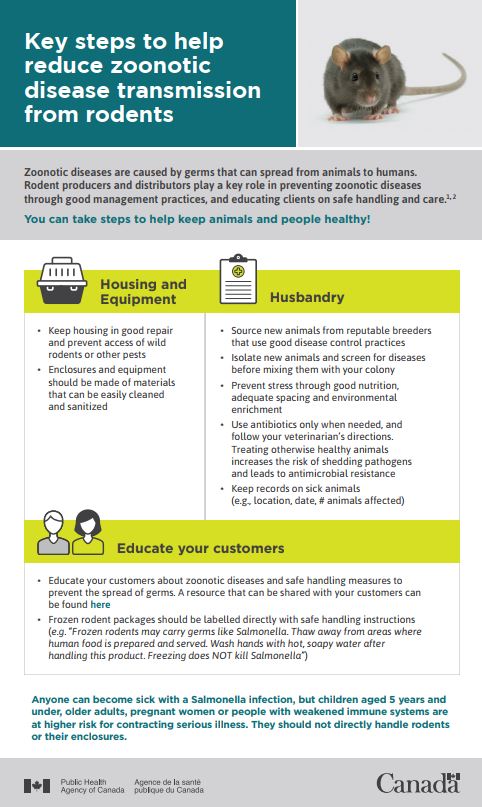Key steps to help reduce zoonotic disease transmission from rodents
Zoonotic diseases are caused by germs that can spread from animals to humans. Rodent producers and distributors play a key role in preventing zoonotic diseases through good management practices, and educating clients on safe handling and careFootnote 1, Footnote 2.
You can take steps to help keep animals and people healthy!
Housing and Equipment
- Keep housing in good repair and prevent access of wild rodents or other pests
- Enclosures and equipment should be made of materials that can be easily cleaned and sanitized
Husbandry
- Source new animals from reputable breeders that use good disease control practices
- Isolate new animals and screen for diseases before mixing them with your colony
- Prevent stress through good nutrition, adequate spacing and environmental enrichment
- Use antibiotics only when needed, and follow your veterinarian's directions. Treating otherwise healthy animals increases the risk of shedding pathogens and leads to antimicrobial resistance
- Keep records on sick animals (e.g., location, date, # animals affected)

Download the alternative format
(PDF format, 227 KB, 2 pages)
Organization: Public Health Agency of Canada
Educate your customers
- Educate your customers about zoonotic diseases and safe handling measures to prevent the spread of germs. A resource that can be shared with your customers is the Postcard: Rodents (pdf).
- Frozen rodent packages should be labelled directly with safe handling instructions (g. "Frozen rodents may carry germs like Salmonella. Thaw away from areas where human food is prepared and served. Wash hands with hot, soapy water after handling this product. Freezing does NOT kill Salmonella")
Anyone can become sick with a Salmonella infection, but children aged 5 years and under, older adults, pregnant women or people with weakened immune systems are at higher risk for contracting serious illness. They should not directly handle rodents or their enclosures.
Hygiene and Cleaning
For all surfaces that animals and animal waste come in contact with:
- Clean
Regularly remove organic material from surfaces by scraping and sweeping BEFORE washing and disinfecting. Dampen surfaces before sweeping to reduce dust - Wash
Regularly wash surfaces with a detergent, soak equipment in warm soapy water, rinse surfaces and equipment with clean water and let dry completely - Disinfect
Use animal-friendly disinfectants preferring phenols or quaternary ammonias, following manufacturer's recommendations Footnote 3. Apply with a sprayer, completely covering surfaces or submerge equipment in a bucket, then rinse - Air dry
All cleaned surfaces, if possible for 24h
For individuals involved with rodent handling:
- Always wash your hands after direct contact with animals, animal waste or contaminated surfaces, using running water and soap for at least 20 seconds.
- Dry your hands with a clean towel or air-dry.
- If soap and water are not available, use hand sanitizer or an alcohol-based hand wipe with at least 60% ethyl alcohol or isopropanol.
For feeder rodents:
- Separate processes of handling dead stock from handling of live animals.
- Regularly clean, wash, and disinfect surfaces between each euthanasia and packaging lot.
- Transport in leak-proof packages and containers and sanitize between shipments.
Useful references:
- Footnote 1
-
PIJAC's Best Management Practices for Feeder Rodent Production and Distribution (July 2017): https://pijac.org/sites/default/files/pdfs/FeederRodentIndustryBMPJuly2017.pdf
- Footnote 2
-
PIJAC Small Animal Care Standards: https://pijac.org/sites/default/files/pdfs/SmallAnimalCareStandards2017.pdf
- Footnote 3
-
Health Canada has a list of approved disinfectants: https://health-products.canada.ca/dpd-bdpp/index-eng.jsp
Page details
- Date modified: